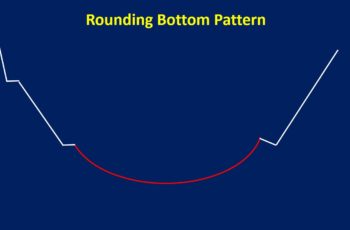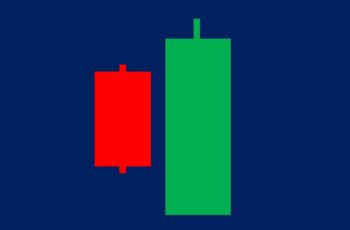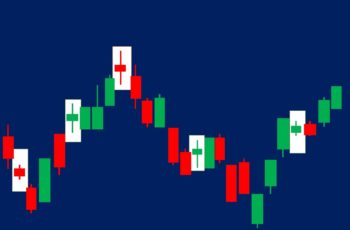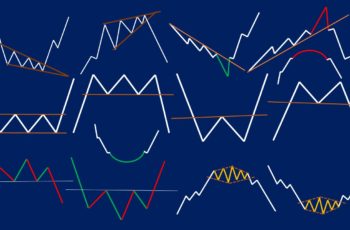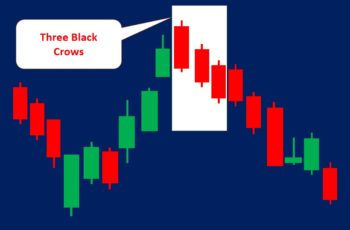Separating lines are continuation candlestick patterns that form during a trend.
There are two types of separating lines: bullish and bearish.
In the following, I explain both versions separately, elaborate on how to trade, and give examples. Moreover, I have compared separating lines with the counterattack lines.
Side note: the first candle may deceive investors by looking like a “belt hold candlestick” pattern, which is a reversal structure. So, make sure to confirm them with other tools and techniques too.
Bullish Separating Lines
As its name implies, a bullish separating lines structure is a bullish continuation pattern. It has two candles and forms during an uptrend and suggests further rise. (check out the first image)
In this pattern, the first candle is a tall or relatively tall red candle, causing worry about the control loss of bears. However, the next session opens at the opening price of the first candle (there is a gap between the closing price of the first candle and the opening price of the second) proposing that the trend is still intact.
In other words, in a bullish separating lines pattern, the opening prices of both candle is the same. However, the first candle closes lower than the opening price and the second candle above.
Bearish Separating Lines
A bearish separating lines pattern is the opposite of the bullish version. It occurs in a downtrend and suggests further price fall. (check out the first image)
In this pattern, the first candle is tall and green, and the second is tall and red. Candles’ opening prices are the same. But, the first candle closes above, and the second candle below the opening price.
How to Trade Separating Lines?
Every candlestick pattern has its qualities. The same is here.
Here are things to consider when you discover this type of pattern:
- Do not be very strict in defining a separating line. It is OK if somehow the closing prices of the first and second vary.
- The size of the candles should be tall enough. It should not be as small as a spinning candle.
- Use it to adjust your stop-loss from its current position to the bottom (in a bullish version) and top (in a bearish version) of the separating line.
- Always blend with other technical tools and charting techniques.
- Confirm if fundamentals support it or not.
I might not have covered everything. But more confirmation leads to better emotion and risk management.
Example of Bullish Separating Lines
In the following chart, Alphabet made four “separating lines” patterns. And one of them did not work.
A cause for concern for the first three patterns was the RSI indicator which showed an overbought condition.
The first pattern appeared after a huge rise. Technically, except for a quick rise, there are no supporting signals. In situations like this structure, adjusting the stop-loss will be a better choice. Because there were no supporting signals, it did not rise fast.
The second structure formed after a hammer. The hammer and small candles indicated that the price is not going to fall. So, it did rise.
The third structure appeared after a gap. But the first candle made a tall upper shadow. Additionally, the RSI remained around an overbought border.
And finally, the last separating lines pattern successfully predicted a good rise. And it had confirmations. The first confirmation was the second candle of this pattern itself, which is a tall green candle. The second confirmation is a gap one session earlier. And, the third one was the RSI which did not show an overbought condition.
All of the above examples explain to us to confirm our patterns. If there is no confirmation, the opposite may happen, or at least the speed will be low.
Example of Bearish Separating Lines
Walmart chart made a bearish separating lines pattern in the middle of January 2022.
A shooting star formed two sessions before this pattern. Technically, a shooting star is a bearish reversal pattern. And it is a confirmation of a bearish continuation pattern.
The second candle of the bearish separating lines has a tall upper shadow. It is another signal that bears are trying to take control of the market.
Moreover, the RSI indicator does not show an overbought or oversold condition. When a leading technical indicator moves normally; it is a sign of continuation of the trend.
Differences Between Separating Lines and Counterattack Lines
Both of these patterns have two candles and the word lines.
However, they are different. And differences are:
- Separating lines are continuation patterns, but the counterattack lines (candlesticks) are reversals.
- In a separating line structure, the opening prices are the same. However, in counterattack lines, it is the closing prices that are the same.
Here is an image comparing them.
Final Words
Separating lines patterns are continuation structures such as “falling three methods” and “rising three methods“.
If you are already in a position with the trend, move your stop loss above (in case of bearish continuation) or under (in case of continuation) of the pattern. And, if you want to open a new position make sure there are supporting signals.

